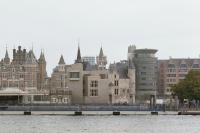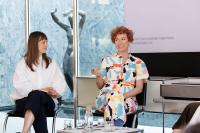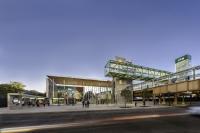Huiming Tea Workshop
Jingning, China
Jingning County, part of Lishui City, Zhejiang Province, is the only She ethnic minority autonomous county in China. The She ethnic minority moved to Jingning, Zhejiang Province from Luoyuan, Fujian Province in the second year of the Tang Dynasty (766 AD). It was originally part of the Southern Chinese nomads.
Chimu Mountain & Huiming Tea
Chimu Mountain, located 10 miles southeast of Jingning County urban center. The northeast half of Chimu Mountain, warm in winter and cool in summer and steaming with clouds and fog, is favorable for tea plantations. Monk Huiming of the Tang Dynasty had built a temple here, who cleared the land around the temple with the She people to plant tea. Named after the monk, Huiming tea has had thousands of years of history and deep cultural heritage. In the mid to late 1970s, several villages near the Huiming Temple were re-integrated, together with their tea plantations to set up a standard and consolidated Huming tea production.
Huiming Tea Workshop
The Huiming Tea Workshop, led by the Chimu Mountain Scenic District Management Committee, serves as a facility for visitors to the scenic area and a place for the daily activities of the surrounding villagers, showcasing the traditional Huiming tea production process, integrating the local She culture with Buddhist culture, and is intended to become a space for Zen tea workshop for the nearby Huiming Temple in the future.
The project site is located in the mid-level tea plantation on the north side of Huiming Temple. The site is flat and runs in north-south directions. It faces a cluster of pine trees on the north hill and the temple gate to the south. Most of the surrounding area has been reclaimed for tea plantation, including leveled terrain to the west, a large drop to the east, and an overview of the county at the foot of the hill to the northeast.
The site's unique topography and the surrounding natural and human environment provide this project with more possibilities.
The building volume is designed as a one-story horizontal block, echoing the gradation of the surrounding tea plantation terraces. As indicators of the site’s direction and scale, it consists of three parallel spaces running north-south: a traditional Huiming tea-making workshop facing the tea plantation, a tea-tasting space facing the distant mountains to the east, and an open corridor in the middle as visitor lounge for observing the tea-making process. Tea making and tea tasting form a complete cycle in experiencing tea culture. The middles visitor lounge is open to the public and a place for rest for both villagers and visitors. The traditional picking and processing of Huiming tea in its harvest season best showcases and demonstrate this craft and will be the most intuitive “agricultural production exhibition” on display.
The east wall of both the workshop and the tearoom is made of perforated block walls, which can protect the workshop as sunshades and separate the tearoom from the visitor lounge. The prefabricated patterns of the blocks are composed of She pictograms. Historically, the She people has a functional oral language without a writing system. Some symbolic graphics formulated over their long-term production and labor to convey simple meanings. The She pictograph blocks on the wall are arranged vertically according to the meaning of the symbols, from the land at the bottom to the sun at the top, re-configuring the She mountain farming and hunting scene, which is the second layer of cultural display of the space.
The natural lighting for the visiting corridor, which runs for nearly fifty meters, has eight light tubes in addition to the entrance and exit at both ends. The choreography of the direct sunlight passing through these tubes indicates the basic rhythm of nature and agriculture.
In ancient China, a year is divided into the 24 Chinese solar terms as the agricultural calender to indicate the alternation of seasons and climate changes. A day is divided into 12 two-hour periods according to each zodiac animal’s activity pattern.
With the most prolonged sunlight hours and the highest solar angle, the summer solstice is also the first of the twenty-four solar terms to be discovered in Chinese history.
The angles and orientations of the eight light tubes are based on the sunlight slopes of the seven Chinese zodiac hours of the summer solstice from sunrise at dawn to sunset at dusk.
The three light tubes of the morning sunlight hours are at rabbit house 5-7am, dragon hour 7-9am, and snake hour 9-11am, intersect from the east tearoom into the visitor lounge, dividing the tea tasting space into four areas, from the public tea space to the small individual tearooms.
At horse hour 11am-1pm, the two parallel light tubes located at the northern end of the visitor lounge indicate the transition of paths.
The three light tubes of the afternoon sunlight hours: at goat hour 1-3 pm, monkey hour 3-5pm and rooster hour 5-7pm, intersect into the tea workshop in the west, dividing the workshop into four processing zones based on traditional tea production procedure.
Around the summer solstice, the direct sunlight of each zodiac hour can only enter the visitor lounge space through the corresponding light tubes. From sunrise to sunset, the natural light passing through different forms of light tubes flows into the space through the various tracks, serving as a sundial to outline the trajectory of time.
In agricultural era, the daily life circle of Chinese tradition “Working from sunrise, Resting when the sun sets”, together with the circles of all lives, animal or plants, are all based on the natural pattern of sun and light.
The space of tea is not only to integrate production and activity, but also to reveal the basic law of nature and the spirit of Zen Buddhism, implying the third layer of exhibition content.
The rooftop is covered with a thin layer of water to dissipate summer heat. A linear walkway in the middle forms a loop with the indoor visitor path leads to the Huming temple atop of the mountain. The eight tubes protrude from the roof, angled at various inclinations and heights to represent the sun's altitude at various times of the summer solstice. Looking from the hills, the water surface reflects the sky and its surrounding. The building transforms into a monumental platform with eight sunlight tubes in dialogue with nature.
- 場所
- Jingning, China
- 年
- 2020


































